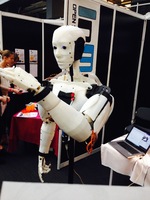Richard Smith, of Igloo in Education and Amazing ICT, recently visited the 3D Print Show in London. What did he make of it?
Hi, Richard Smith here from Igloo in Education. I am delighted to have been asked by Terry to do a guest blog post on the 3D print show that took place in London from 7-9th November.
 One of these might be handy to have around the house! Photo by Richard SmithThe venue of the event, the Business Design Centre in Islington, sent out a clear message out to visitors: 3D printing should be about innovative design and the encouragement of original business ideas. Of course schools and colleges need to discuss what type of printer is best, consider the plethora of materials that can be used and consider running costs. However, as teachers, we need to spend the majority of our time discussing ideas that would work well and be accessible to the youngsters we teach.
One of these might be handy to have around the house! Photo by Richard SmithThe venue of the event, the Business Design Centre in Islington, sent out a clear message out to visitors: 3D printing should be about innovative design and the encouragement of original business ideas. Of course schools and colleges need to discuss what type of printer is best, consider the plethora of materials that can be used and consider running costs. However, as teachers, we need to spend the majority of our time discussing ideas that would work well and be accessible to the youngsters we teach.
The technology isn’t as complicated as it seems. A nozzle squirts out smooth material at a fixed speed. This nozzle moves in 3 dimensions (x,y and z) based on the design created by the student on a computer. Layers of the material build up to reveal the finished product.
Yes, I know I have missed out that the file needs to be exported as an STL file and that you have to choose filament materials such as ABS, Nylon and PLA. You also need to decide if the printer needs a hot bed and the number of microns it works best at. However, it is the creative side of this technology that will excite most teachers and students. With Iron Man. Some parts of the suit were created on a 3D printer. Photo by Richard Smith
With Iron Man. Some parts of the suit were created on a 3D printer. Photo by Richard Smith
I was delighted to see how Playkide gets students to design tiny buildings on paper and a CAD program. These are then printed in 3D to be included in a big kidville town. Discussion is about design and collaboration rather than the technical issues of printing.
Collaboration seems important to this 3D printing community. You can start a project before you have your own 3D printer by joining a hub and using someone else’s for a small price. The world map of printers is intriguing and emphasises that communities see this as a technology that is worth investigating. See 3D Hubs .
I was pleased to see some free software and apps to encourage the exploration of 3D. For example, 123dCreature from Autodesk allows you to create your own 3D creature using a free app for the iPad. This can be shared and printed too.
I loved the innovation of Printcraft in which students created models from small blocks using the online game Minecraft and then could print them in 3dD so they had a physical object too. This project has been funded by Nesta.
There are further examples of educational excellence here, in the Awards section of the 3D Print Show website.
 Examples of 3D print-outs. Photo by Richard SmithI was really delighted to meet Brook Drumm from Printrbot who encouraged me to build a 3d printer from scratch for $299. His description of the way people share ideas and downloadable files made it clear that this is a supportive community ideal for education. There are a number of kits on the market and this may be a great idea for an after school club or small group of students.
Examples of 3D print-outs. Photo by Richard SmithI was really delighted to meet Brook Drumm from Printrbot who encouraged me to build a 3d printer from scratch for $299. His description of the way people share ideas and downloadable files made it clear that this is a supportive community ideal for education. There are a number of kits on the market and this may be a great idea for an after school club or small group of students.
If you prefer just to buy the hardware, unpack it and use it then there is a great array of companies available. Robust models start at around £1200. Cost increases based on brand name, the size of the base and the quality of the case and workings. You can see the three consumer printers shortlisted for awards by clicking Consumer Printers. Alternatively, investigate local universities and businesses to see what expertise is near to you. For example RPTechWorks from Birmingham was started by graduates at Warwick University. Local knowledge and support may be invaluable as you develop your own 3D community.
The 3D printer community is very open in terms of sharing ideas and codes via the open source community. This fits in well with the changes that are taking place in the technology curriculum. I believe that students should be able to create a 3D model using free software such as Sketchup, save their work, export it in a suitable format (such as .STL) and then understand that these instructions (code) can control a printer moving in 3 dimensions.
And remember: try to focus on the creative ideas and not on the technology!
 Richard SmithRichard is Director of Education at Igloo in Education (www.iglooineducation.com) and at Amazing ICT (www.amazingict.co.uk).
Richard SmithRichard is Director of Education at Igloo in Education (www.iglooineducation.com) and at Amazing ICT (www.amazingict.co.uk).
